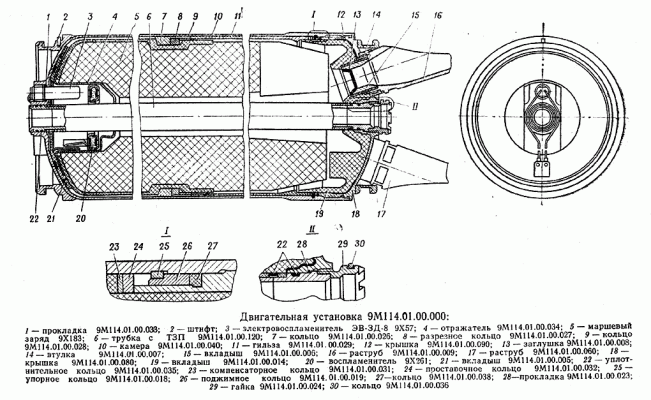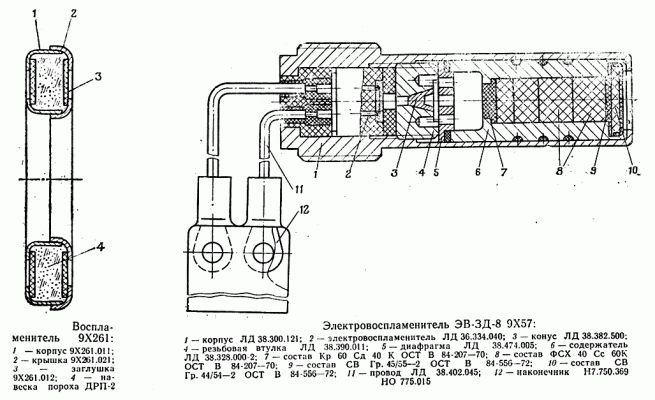The remote control is a single-chamber dual-mode solid fuel jet engine and consists of chamber 10, lid 12, sleeve 11, tube 6 with TCP, marching charge 5 (charge 9X183), igniter 20 marching charge (igniter 9X261) and electric ignitor EV-ZD-8 9X573. Chamber 10 is made of steel in the form of a thin-walled shell with a spherical bottom, which is protected from the thermal effects of powder gases by an insert 21 of heat-proof material.
The lid 12 consists of a lid 18 made of a titanium alloy with a lining 19 made of a heat-protective material and two sockets 17. The latter consist of steel sockets 16 with lugs 15, on the outer surface of which there are sleeves 14 made of a heat-protective material.
The tightness of the remote control and a certain pressure level at the moment of ignition of the charge 9X183 are provided by plugs 13. The tightness of the remote control at the junction of the cover 12 and chamber 10 is achieved by compressing the rubber ring 27 by the end of the cover on one side and the clamping ring 26, thrust 25 on the other. Rubber ring 30 is used to seal the joint between the remote control and the instrument compartment. Pins 2 ensure the location of the instrument compartment relative to the steering (in angular relationship).
The sleeve 11 together with rings 7, 8, 9, 23 is designed to protect the heat-stressed part of the chamber from the effects of hot powder gases and at the same time is a power element that absorbs forces from the charge 9X183 at the moment of start.
Tube 6 with TZP is designed to protect the wire connection between the instrument and steering compartments from the thermal effects of powder gases. It is a steel tube, the outer surface of which is covered with a thermal protection material. The tightness at the joint of the tube with the camera and the lid is ensured by rings 22 and gasket 28. The tube is mounted in the remote control with nut 29.
Charge 9X183 5 is a single-channel draughtsman with four slots, booked on a spherical and partially on a cylindrical surface to ensure dual-mode operation of the remote control. The armour of the 9X183 charge has an annular groove required to accommodate ring 7, split ring 8 and ring 9 when the 9X183 charge is secured in the remote control chamber. For installation of the electric ignitor EV-ZD-8 9X57 and reflector 4 with ignitor 9X261 there is a dart in the front part of charge 9X183.
The 9X261 igniter is designed to ignite the 9X183 and consists of the case 1, the cover 2 and the gunpowder hood DRP-2. To improve the ignition process of the 9X183 charge, the flat surfaces of the lid and housing have windows glued with plugs 3. Reflector 4, in which the igniter 9X261 is installed, protects the surface of charge 9X183 from the direct force of the flame force of electric igniter EV-ZD-8 9X57.
Electric ignitor EV-ZD-8 9X57 is designed to activate the remote control in 0.09 from the moment the projectile starts moving. Electric igniter EV-ZD-8 consists of the body 1 (Fig. 3), electric igniter 2, cone 3, threaded bushing 4, diaphragm 5, containing 6, in which are pressed ignition 7, 9, slowing down 8, ignition 10 compositions, and wires 11 with lugs 12. Sealing of the junction of the electric ignitor ED-ZD-8 9X57 and the bottom of the chamber is provided by laying 1 (Fig. 1).
Operation of the propulsion system.
When the voltage from the TGIP on the contacts of the electric igniter EV-ZD-8 9X57 triggered electric igniter, which ignites the ignition composition. The combustion from the igniting composition is transferred by the deceleration composition after 0.09 with the igniting composition, which gives the flame force to the igniter 9X261. Ignition agent 9X261 ignites a 9X183 charge. When the pressure in the chamber of the remote control reaches 25-35 kgf/cm2, the plugs are destroyed and the flow of gases begins with the formation of reactive force. The propulsion system, due to the geometry of the charge in the 1st mode, develops a thrust up to 760 kgf and within 2 seconds accelerates the projectile to the specified speed. In order to maintain this speed, the propulsion system operates at mode 2, developing a thrust of up to 360 kgf. After 5 s from the moment of ignition of the charge 9X183 remote control stops working, and further movement of the projectile is due to the received kinetic energy.

